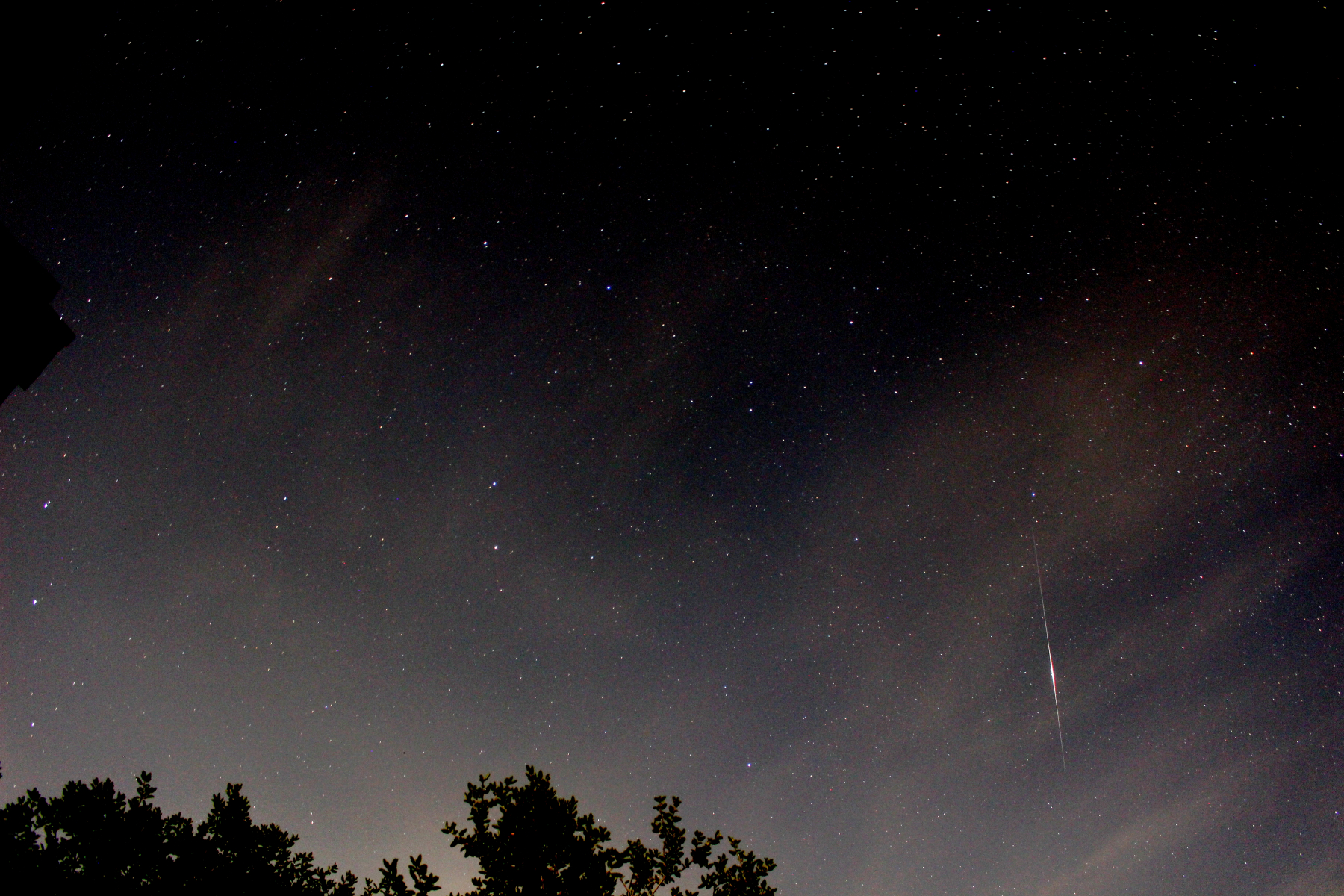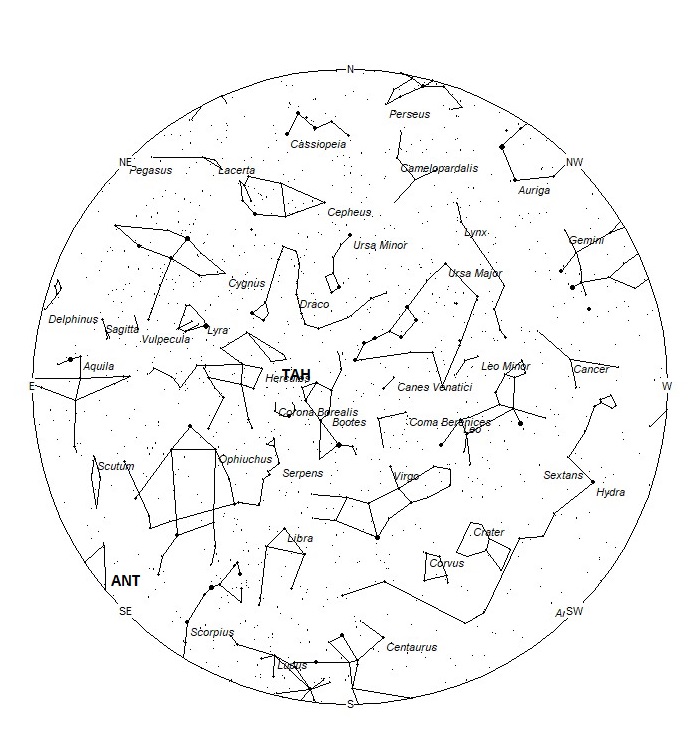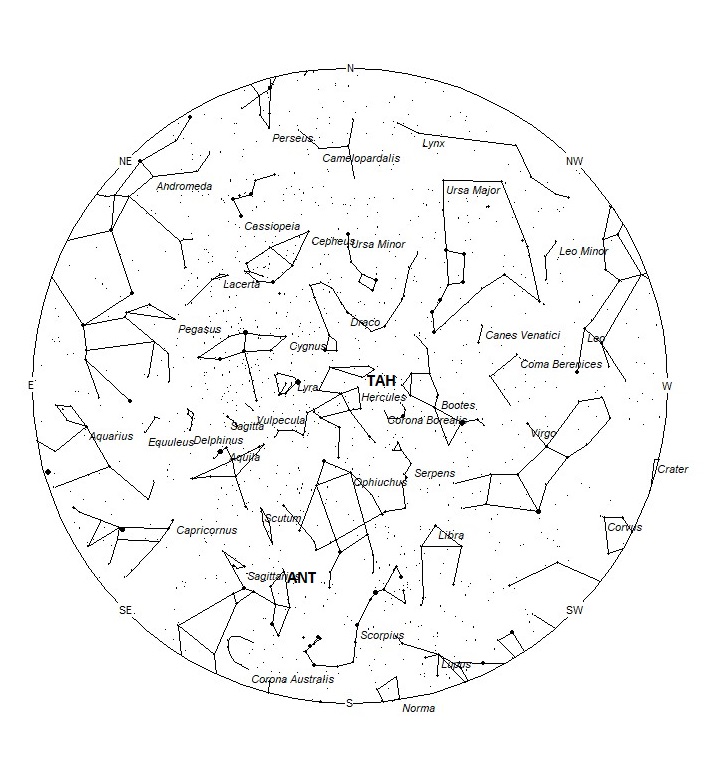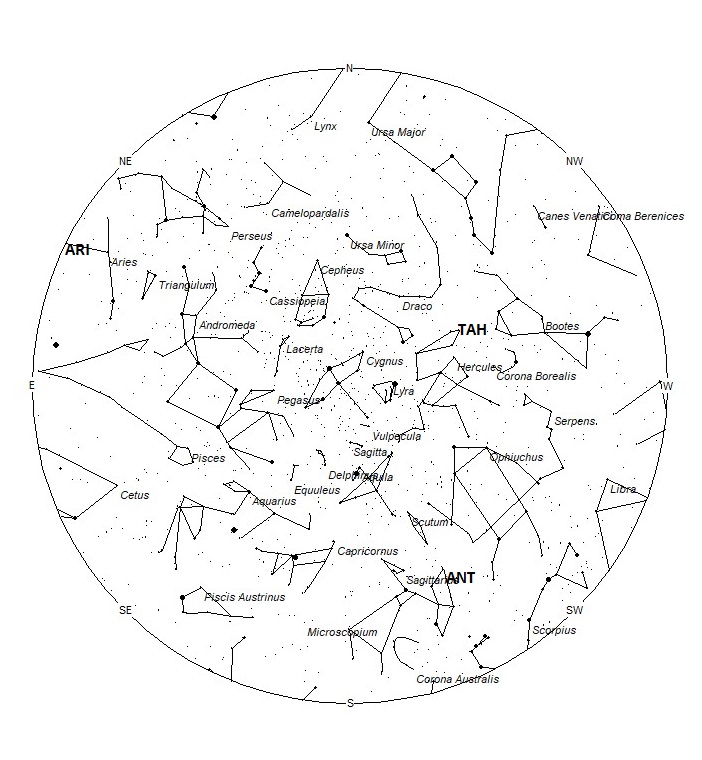 David Young captured this nice flaring meteor at 11:39 UT (4:39 PDT) on April 29, 2021, from Fremont, California, USA. ©David Young
David Young captured this nice flaring meteor at 11:39 UT (4:39 PDT) on April 29, 2021, from Fremont, California, USA. ©David YoungDuring this period, the moon reaches its new phase on Thursday June 10th. On this date the moon is located near the sun and is invisible at night. This weekend the waning crescent moon will rise during the early morning hours but will not interfere with viewing meteor activity as long as it is not within your field of view. The estimated total hourly meteor rates for evening observers this week is near 3 as seen from mid-northern latitudes (45N) and 4 as seen from tropical southern locations (25S). For morning observers, the estimated total hourly rates should be near 7 as seen from mid-northern latitudes (45N) and 12 as seen from tropical southern locations (25S). The actual rates will also depend on factors such as personal light and motion perception, local weather conditions, alertness, and experience in watching meteor activity. Note that the hourly rates listed below are estimates as viewed from dark sky sites away from urban light sources. Observers viewing from urban areas will see less activity as only the brighter meteors will be visible from such locations.
The radiant (the area of the sky where meteors appear to shoot from) positions and rates listed below are exact for Saturday night/Sunday morning June 5/6. These positions do not change greatly day to day so the listed coordinates may be used during this entire period. Most star atlases (available at science stores and planetariums) will provide maps with grid lines of the celestial coordinates so that you may find out exactly where these positions are located in the sky. A planisphere or computer planetarium program is also useful in showing the sky at any time of night on any date of the year. Activity from each radiant is best seen when it is positioned highest in the sky, either due north or south along the meridian, depending on your latitude. It must be remembered that meteor activity is rarely seen at the radiant position. Rather they shoot outwards from the radiant, so it is best to center your field of view so that the radiant lies at the edge and not the center. Viewing there will allow you to easily trace the path of each meteor back to the radiant (if it is a shower member) or in another direction if it is sporadic. Meteor activity is not seen from radiants that are located far below the horizon. The positions below are listed in a west to east manner in order of right ascension (celestial longitude). The positions listed first are located further west therefore are accessible earlier in the night while those listed further down the list rise later in the night.
These sources of meteoric activity are expected to be active this week.
.
The tau Herculids (TAH) are an irregular shower not active every year. They are best known for being associated with comet Schwassmann-Wachmann 3 and the strong display seen in 1930. Due to recent activity from the comet, this shower could produce more activity in upcoming years. The Earth could start encountering particles from Schwassmann-Wachmann 3 around May 19. The current radiant location is expected to lie near 15:25 (231) +39. This area of the sky is located in northern Corona Borealis, 3 degrees northeast of the 4th magnitude star known as Alkalurops (mu1 Bootis). This is not that close to the star tau Herculis, for which this shower is named. Apparently, the discoverers of this display placed the radiant further east toward Corona Borealis and Hercules. It’s also possible that past displays from this source had a different radiant area. This area of the sky is best placed near midnight local daylight saving time (LDST), when it lies high overhead for observers located in mid-northern latitudes. Rates are expected to be less than 1 meteor per night at this early stage. With an entry velocity of 15 km/sec., the average tau Herculid meteor would be of very slow velocity.
The center of the large Anthelion (ANT) radiant is currently located at 17:55 (268) -23. This position lies in western Sagittarius, 8 degrees northwest of the 3rd magnitude star known as Kaus Borealis (lambda Sagittarii). Due to the large size of this radiant, Anthelion activity may also appear from southeastern Ophiuchus as well as western Sagittarius. This radiant is best placed near 0200 LDST, when it lies on the meridian and is located highest in the sky. Rates at this time should be near 2 per hour as seen from the Northern Hemisphere and 3 per hour as seen from south of the equator. With an entry velocity of 30 km/sec., the average Anthelion meteor would be of slow velocity.
The Daytime Arietids (ARI) are active from May 29-June 17 with maximum activity occurring on June 4th. These meteors are difficult to catch as the radiant only lies 30 degrees west of the sun. Therefore, the only time these meteors are visible is during the last dark hour before dawn. The radiant is currently located at 02:52 (043) +24. This area of the sky is located in northern Aries, 3 degrees south of the 4th magnitude star known as 41 Arietis. Current rates are expected to be less than 1 no matter your location. With an entry velocity of 41 km/sec., the average meteor from this source would be of medium velocity.
As seen from the mid-northern hemisphere (45N) one would expect to see approximately 5 sporadic meteors per hour during the last hour before dawn as seen from rural observing sites. Evening rates would be near 2 per hour. As seen from the tropical southern latitudes (25S), morning rates would be near 9 per hour as seen from rural observing sites and 3 per hour during the evening hours. Locations between these two extremes would see activity between the listed figures. Rates are reduced due to moonlight.
| SHOWER | DATE OF MAXIMUM ACTIVITY | CELESTIAL POSITION | ENTRY VELOCITY | CULMINATION | HOURLY RATE | CLASS |
| RA (RA in Deg.) DEC | Km/Sec | Local Daylight Saving Time | North-South | |||
| tau Herculids (TAH) | Jun 02 | 15:25 (231) +39 | 15 | 00:00 | <1 – <1 | III |
| Anthelion (ANT) | – | 17:55 (268) -23 | 30 | 02:00 | 2 – 3 | II |
| Daytime Arietids (ARI) | Jun 04 | 02:52 (043) +24 | 41 | 11:00 | <1 – <1 | IV |
 American Meteor Society
American Meteor Society



I believe I just witnessed a shooting star in mi Minnesota at about midnight June 7th
OH EM GEE
I just saw a shooting star or something.. it was bright and green at the end
Just saw one 19:55pm Minneola 168 north